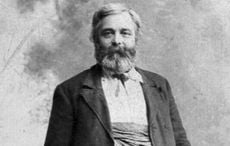The Irish potato famine of the 1840s and 1850s was probably the greatest human tragedy of the 19th century. The famine sparked a massive wave of emigration to America, with more than two million Irish men, women, and children leaving their homeland for the New World. Their presence on American shores added a distinctive Irish flavor to the so-called “melting pot,” as Irish immigrants raised families, built communities, and made a place for themselves in their adopted country.
Hundreds of thousands of these Irish immigrants were young men, and their arrival created a potential new source of participants for America’s most rapidly growing sport. Baseball was an activity that the immigrant Irishman could engage in to become part of his adopted country. Through it, the Irishman could fit in and excel at something distinctly American. While the older generation could not always understand this strange new pastime and its appeal, their young men embraced it with enthusiasm. Professional baseball, which took root in America shortly after the Civil War, was attractive to the ambitious immigrant, and it did not take long for the Irish to gain a foothold in the increasingly popular sport.
The National League began play in 1876, just as the sons of Irish famine refugees were reaching adulthood, and the number of Irish players in the league grew with each passing year. One Irishman of note was Roger Connor, a Connecticut native whose Irish-born father had frowned on his son’s interest in the new American game. Roger was nonetheless determined to make good in baseball. A handsome, muscular first baseman, the hard-hitting Connor soon became the most popular player in New York, where the fans called him “Dear Old Roger.” Connor, proud of his ancestry, wore a bright green shamrock stitched to his uniform shirt. When he retired from the game in 1897, he held the career record for home runs, a mark which was later broken by Babe Ruth.
Connor, however, was only one of a legion of Irish stars in early baseball. It has been estimated that more than 40 percent of all major league players during this era were Irish Americans; among them were pitchers Jim (Pud) Galvin and Tim Keefe, the first two major leaguers to win 300 games, and Hugh Duffy, whose .440 batting average in 1894 has never been surpassed. So many of the batting champions and pitching leaders of the era were Irishmen that there are almost too many to name.
The grandest Irish-American player of them all during this era was Mike Kelly, the “King of Ballplayers.” Born to Irish immigrants in Lansingburgh (now part of Troy), New York, on New Year’s Eve in 1857, Mike Kelly treated every day as a party. This multitalented player, who saw action at both catcher and shortstop as well as in the outfield, joined the Chicago White Stockings in 1880 after two years with the Cincinnati Reds. He drove manager Cap Anson crazy with his carefree behavior, but his on-field brilliance keyed the Chicago attack and led the White Stockings to five pennants in seven years. Before long he was “King” Kelly, baseball’s first matinee idol and hero to Irish-Americans across the nation.
The King smoked cigarettes on the bench, and once, when asked if he drank alcohol during games, replied cheerfully, “It depends on the length of the game.” He invented new ways to slide into bases, raising large clouds of dust as the fans cheered, “Slide, Kelly, slide!” He was also known to hide an extra ball in his uniform shirt for special occasions. One day, Kelly was in right field late in the game as the setting sun cast twilight over the field. The batter belted a liner to right, and Kelly made a spectacular headlong dive in the darkness, rising with the ball in his hand as the crowd cheered his game-saving play. Anson complimented him on the catch. “What catch?” asked Kelly in his Irish brogue. “The ball went a mile over me head.” He had “caught” the extra ball, not the game ball.
The Chicago team was built around Irish-American ballplayers, with pitcher Larry Corcoran (who threw three no-hitters during his short career), catcher Frank (Silver) Flint, and third baseman Tom Burns also attaining stardom. However, Kelly always commanded the most attention. Sold to Boston in 1887 for the then-record sum of $10,000, Kelly was so popular that the Irish fans of the Hub bought him a house, complete with a horse-drawn carriage to convey their hero to the game each day. Sometimes the Boston Irish put the carriage aside and carried Kelly to the ballpark on their shoulders. The King’s stardom fizzled out after a while – whiskey and high living ended his career in 1893 and his life one year later – but Mike Kelly remains a symbol of Irish-American supremacy of early baseball.
The Irish also dominated the umpiring ranks. The umpiring profession was a thankless one at the time, with only one arbiter present to keep order in games often marked by chaos and rowdiness. Arguments, fan violence, and even fistfights between players and umpires were common during the 1880s and 1890s, and only the strongest umpires survived. Many failed, but skilled, dedicated Irishmen such as “Honest John” Gaffney and “Honest John” Kelly prospered. Gaffney, who conducted each game with patience and tact rather than physical intimidation, was the first man to be called “King of Umpires.”
Perhaps the most colorful umpire of the period was Tim Hurst, who grew up in the coal mining country of Pennsylvania and brought a sharp wit and quick fists to the National League in 1892. Hurst, who had learned to box while working in the mines, gave his decisions in a thick Irish brogue and took no nonsense from anyone. He once flattened an unruly fan with his mask during an argument, then did the same to a police officer who tried to intervene. In 1897, after receiving a constant stream of abuse from several Pittsburgh Pirates, the umpire invited three players to meet him under the stands after the game. Hurst took them all on at once and emerged the victor. Despite his temper, Hurst knew the rule book inside and out, and many players considered him the most skilled arbiter in the league.
Hurst agreed with that assessment. He wore a cap with the letter B on it; when asked why, Hurst replied, “Because I’m the best.” He kept control of the game, though some players found the quick-witted Hurst so entertaining that they started arguments with him just to hear him talk in his colorful Irish accent.
The Baltimore Orioles, who dominated the National League during the mid-1890s, were almost totally Irish in character. Manager Ned Hanlon, an outstanding judge of talent with a penchant for hiring his fellow Irishmen, built the also-ran Orioles into a contender with a series of trades and free-agent signings. His scrappiest player was John McGraw, a third baseman whose parents had left County Tipperary years before and settled in the farming community of Truxton, New York. McGraw weighed only 121 pounds when he arrived in Baltimore at age 18, but his will to succeed was second to none, and he made himself into a star under Hanlon’s direction. The speedy McGraw taught himself to foul off pitches, one after another, until he took a walk or found a pitch he could slap into the outfield for a single. Despite his youth, he made himself the field leader of the Orioles, urging his teammates to “Get at ’em!”
McGraw, who was known to trip opposing baserunners or grab their belts to prevent them from rounding third, led the way in bullying opponents, manhandling umpires, and generally causing mayhem in the pursuit of winning. To McGraw, winning was everything, whatever the cost. He and his fellow Irish Orioles – outfielders Joe Kelley and Wee Willie Keeler, shortstop Hugh Jennings, second baseman “Kid” Gleason, and others – followed McGraw’s example and battled their way to the top of the league. The Orioles were the most unpopular team in the circuit, but brought three pennants to Baltimore from 1894 to 1896. Many of these same Irish stars (though not McGraw) followed Ned Hanlon to Brooklyn several years later and won two more pennants in 1899 and 1900.
A new circuit, the American League, began play in 1901 with several Irish Americans in key roles. Jimmy Collins, star third baseman for the Boston club of the National League, jumped to the new league and became the playing manager of a new contender, the Boston Americans (now called the Red Sox). Collins, who imported several Irish stars from the old league, won two pennants and defeated Pittsburgh in the first modern World Series in 1903. Another important figure was Connie Mack, whose name was Cornelius McGillicuddy at his birth in 1862. Mack, whose immigrant father fought in an all-Irish regiment during the Civil War, was a soft-spoken and gentlemanly manager who bore no resemblance to the fiery John McGraw apart from his Irish ancestry. Mack took charge of the Philadelphia Athletics in 1901 and led the team to nine pennants and a then-record five World Series titles in a career that lasted until 1950.
John McGraw was appointed manager of the moribund New York Giants in 1902, and, following the example of his mentor Hanlon, built the Giants into a powerhouse with a largely Irish roster. However, the Irish dominance of baseball had abated by this time, with the percentage of German Americans on major league teams surpassing that of the Irish by 1900. Indeed, the Chicago Cubs, chief rivals of the revitalized Giants, were an almost totally German team; McGraw publicly sneered at the “Dutchmen” in Chicago, but the Cubs won four pennants and two World Series from 1906 to 1910. McGraw’s “Hibernian Giants” rebounded with pennants in 1911, 1912, and 1913, but lost all three World Series. The Irish no longer ruled the game, and as other ethnic groups (Italians, Eastern Europeans, and Scandinavians among them) entered the fray, the Irish became merely one of a number of nationalities represented on major league rosters.
Though Irishmen began to disappear from the playing ranks, they remained a force in the managerial end of the game. Slightly more than half of all major league managers during the 1910-1920 period claimed Irish descent, and Irish-American managers won 13 of the first 16 American League pennants beginning in 1901. John McGraw, who led the Giants until 1932, and Connie Mack were only two of the many successful Irish-American field leaders who left their mark on the game during the first half of the 20th century. From 1932 to 1960, the New York Yankees won 18 pennants and 14 World Series titles under two outstanding managers, the fully Irish Joe McCarthy and the half-Irish Casey Stengel.
Baseball eventually lost its Irish flavor, and today the game is more ethnically diverse than ever. The Irish made a significant contribution to the national pastime in its formative years, but now, more than 130 years after the first National League game was played, Irish-Americans make up only a tiny percentage of major league players. Irish domination of the game has passed into the realm of history.
David Fleitz, a writer and sports historian from Royal Oak, Michigan, is the author of The Irish in Baseball: An Early History.
The book was released by McFarland Publishing in May of 2009.




Comments